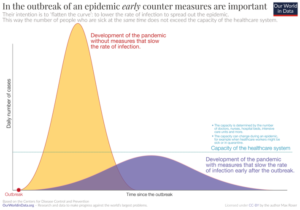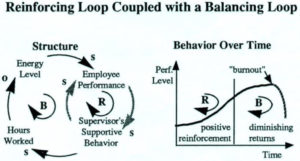The ongoing coronavirus/covid-19 pandemic is a tragedy. Many people have already died from the virus and many more will follow. The double tragedy of the virus outbreak itself and the economic crisis due to the attempts to slow down the spread of the disease, doubles up the effects of this black swan event.

In the light of the potential threat of the virus in combination with fast and non-predictable disruptions in our societies, it is not surprising that the outbreak is accompanied with a lot of anxiety and even horror. It is potentially scary indeed to listen to daily reports on the rising number of deaths, hearing about people you know catching the disease and passing away, and perhaps catching the illness yourself, as the new and unknown disease is unfolding around us. However, we tend to fear the most those things that we understand the least. Understanding the dynamics of the disease and the societal disruptions themselves is a key to diminishing and handling the anxiety it might bring.
This is also true in the attempt to help others coping with their fears of the development – not least of all in (virtual) classrooms around the world where educators try their best to calm their students. Many young people are afraid and their teachers can do a lot to help them not only to manage, but actually even to learn from the current global event.
In its initial phases, a pandemic is exponential on almost any measure: the number of new cases per day in a region; the number of patients in intensive care; the number of deaths; and so on. This is true up to a certain point in time, when curves tend to flatten – either because a high enough fraction of the population has acquired some level of immunity or resistance to the virus, or because interventions to stop or reduce the paste of the outbreak are having effect. Much of the dynamics of the pandemic can be understood by understanding the tension between exponential growth and the dampening effects of balancing feedback loops.

Feedback loops are at the core of systems thinking, and understanding systems is to a high extent all about understanding feedback between interconnected components of the system. Fostering a systems thinking is key to understanding almost any part of the world we live in, and certainly for understanding a pandemic outbreak. In education for sustainable development, systems thinking is identified as one of the key competences that all students should acquire for being able to contribute to a sustainable society, as the development and dynamics of everything around us is unfolding as development of systems. This is true for the climate system, where reinforcing feedback loops may cause global warming to spiral out of hand. For example, when the melting of polar ice causes Earth’s albedo to drop, trapping more of the incoming sun light within the system and reinforcing global warming – leading to more polar ice melting and so on. This is however to a certain extent compensated by dampening feedback loops such as global warming also leading to an increase in cloud formation, rising Earth’s albedo and thus reflecting more sunlight back into space and therefore cooling the planet. The climate system can only be understood by understanding the tension between (exponential) reinforcing feedback loops and dampening (balancing) feedback loops.

The same is true for man-made systems. Take the global economy: it consists of a complex mix of components affecting one another in complicated patterns, which gives rise to feedback loops some of which are reinforcing and some are dampening. For example, without any outside restrictions or interventions, a factory producing goods is an example of an exponentially reinforcing feedback loop. For each product item it delivers, it produces revenue that can partly be invested in the production system to increase future production rate and therefore revenues. If the factory was producing in a vacuum without any boundaries, this feedback loop alone would cause exponential growth in productivity. In reality, reinforcing feedback loops are, on the longer term, balanced by dampening feedback loops that are keeping the balance of the system. In the example of the production facility, examples of dampening feedback loops would be the effects of competition, taxes, and limited resources.
Similarly, we see complex systems all around us, working along the same general dynamics of competing (exponential) reinforcing versus dampening (balancing) feedback loops. On a general level, this is true for the dynamics of any system including ecosystems, geophysical systems (the circulation of rock and magma from Earth’s interior to the surface in volcanoes and back again in the oceans’ subduction zones), hydrophysical systems (the circulation of water as vapour from land and oceans into rain clouds, falling down forming lakes and glaciers and finally pouring back into oceans again). Even human psychology is working on the same basic principles: in general dampening biochemical feedback loops in our central neural system are keeping and balancing levels which causes a fairly stable mood (in most people), but sudden outbreaks of electrical and chemical signals trigger feedback loops in the form of chain reactions to go off, which changes mood from one meta-stable state to another meta-stable state.
In fact, one of the features that would reveal that you are dealing with a complex system governed by feedback loops, is that there exists some type of stable or meta-stable state that can be interrupted by the onset of exponential growth of some parameter. The shift from the meta-stable state can only be exponential for some time though before limiting feedback loops kick in and the system may acquire another meta-stable state. For example, the climate system has been shifting between two meta-stable states for several million years (until humans came about and disturbed the system into another direction), namely the about 100,000 years long ice ages interrupted by shorter, about 10,000 years long interglacial periods (as the current one). The same dynamics work for the pandemic as well: there may exist several meta-stable states in the population, at least two of which would be (1) a population with no (or only infinitesimal) level of infection, and (2) a population with a high degree of resilience to infection (due to immune system resistance). The respective state is fairly stable but the transition between states is rapid (on the time scale of weeks or months).
Understanding systems and feedback loops is key to understanding anything in the natural world as well as human-made systems. This is why I and others with me advocate for integrating systems thinking in all education as this is one of the most important skills to learn for enabling a sustainable development to happen. It is only by understanding systems we can truly understand the world, and it is only by understanding the world we can put the right and most efficient interventions in place to change development of the world’s natural and human-made systems onto paths that are sustainable on the longer term.
The same is true for handling this pandemic. Indeed, a viral outbreak is a great example of a sustainability issue. In my own classroom teaching, I have often used the exponential growth of a virus as an example of a sustainability issue that can be understood by system dynamics. The growth is exponential and the potential interventions are effective depending on the level of damping they can provide. If an intervention does provide damping, it may prove efficient in slowing down the process by decreasing the rate of growth. However, the situation must also be understood as a whole-system where the viral outbreak is but a part of a larger system: interventions to decrease viral growth do indeed have other effects, such as dampening productivity which ultimately can lead to another phase shift in the system if it causes an economic crisis and even economic collapse. In such case the number of deaths from other causes, such as famine and the spiking of other diseases, would potentially outnumber the potential deaths of the pandemic outbreak by several orders of magnitude – by which end nothing would had been won and a lot would had been lost. This is why handling the pandemic is a very delicate and difficult matter for governments and agencies around the world, and it is by no means certain that one approach to dealing with the situation will be more efficient than any other.
This is however not to say that we have no clue. The key for understanding the pandemic, and to maximise the chances for handling it correctly, is to understand it as a complex system with feedback loops. ‘Complex’ does not mean that we cannot understand it, it just means that we cannot be certain of how it will develop. But with better understanding of the system we will certainly have a better chance of doing the right thing than if we were shooting completely blind (which by the way some governments seem to be doing).
To conclude, the dynamics of this pandemic is very similar to the dynamics of any system. As in any system, where we have the possibility to affect the system, maximising the chance for an as beneficial dynamics as possible, can only be achieved by understanding the feedback loops of the system. And the first step in understanding those, is to attain a systems thinking approach and learn the basics about feedback loops.
A great way to learn feedback loops is though the simulation game FishBanks. If you are following what I am writing and lecturing about you may know that I am a keen promoter of games as tools for learning, and that I and my colleagues have developed many learning packages around sustainability and systems thinking. Please check them out here if you are interested, and do write a comment or share this article if you liked it. And by the way, another great game for understanding the dynamics of the current crisis is Pandemic.

